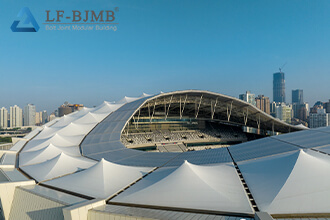+86 177 5193 6871
222, Block B, Diamond International, Guozhuang Road, Xuzhou, Jiangsu, China

In membrane structures, common membrane materials are usually characterised by light weight, flexibility, transparency and weather resistance to meet the various requirements of building design. The following are some common membrane materials:
Polytetrafluoroethylene (PTFE) Membrane: PTFE membrane is a material that is weather, chemical and heat resistant. It is commonly used to create permanent structures such as gymnasiums and large buildings.
Polyvinyl Chloride (PVC): PVC film is an affordable option that is widely used for temporary and semi-permanent structures such as event tents and exhibition halls.
Polyester Film: Polyester film is commonly used to create transparent or translucent cover structures that provide good light. It also has some UV resistance.
Glass Fibre Reinforced Polymer (PVC/PES): This membrane material combines the advantages of PVC and polyester membranes to provide good strength and durability.
Fluorocarbon Membrane: Fluorocarbon membranes with good weathering and chemical resistance are often used for permanent structures such as sports stadiums and airports.
Transparent Membrane: Some membrane structures need to provide good transparency to enhance the light effect. Transparent membranes can be PVC, polyester or other transparent materials.
When selecting membrane materials, the needs of the building design need to be considered, including lighting effect, thermal insulation, weather resistance, cost and other factors. In addition, the design of membrane structure also needs to consider the engineering aspects of structural frame, tensioning system and supporting structure.
